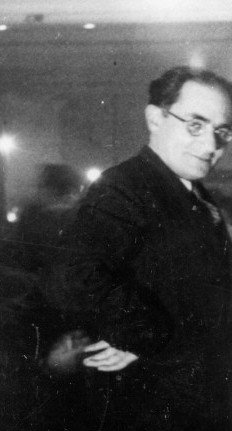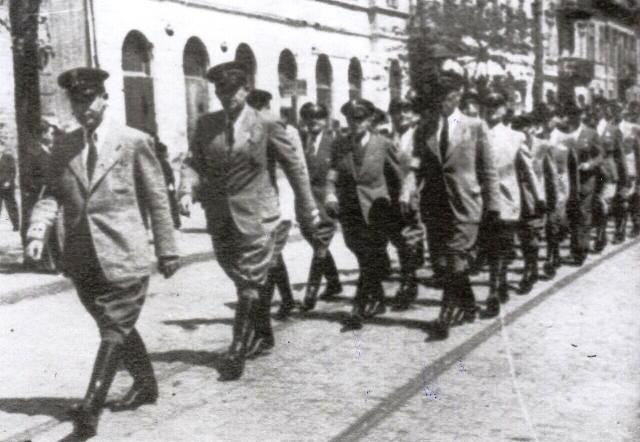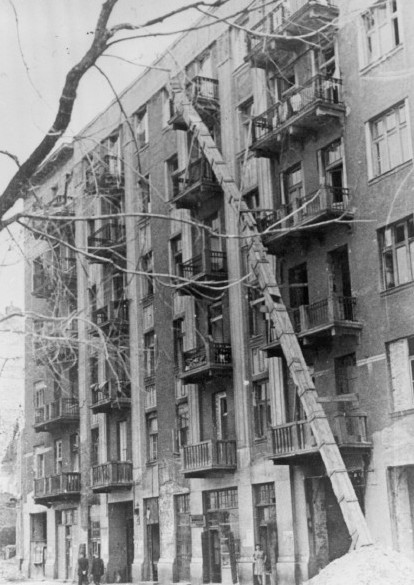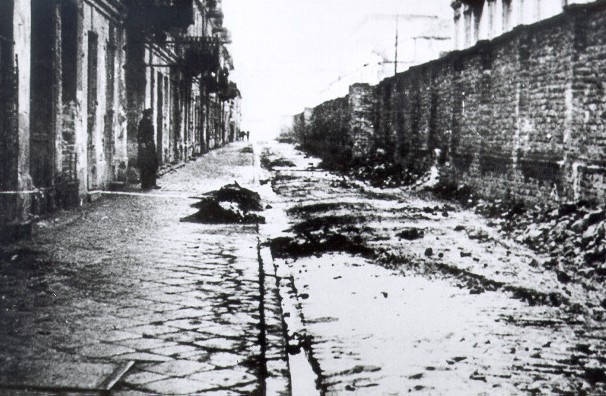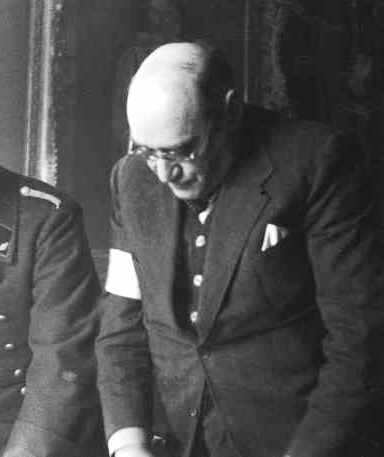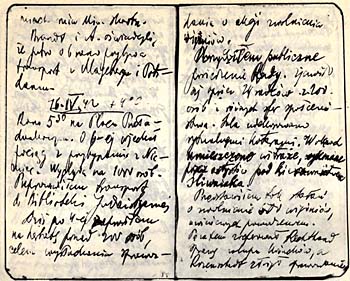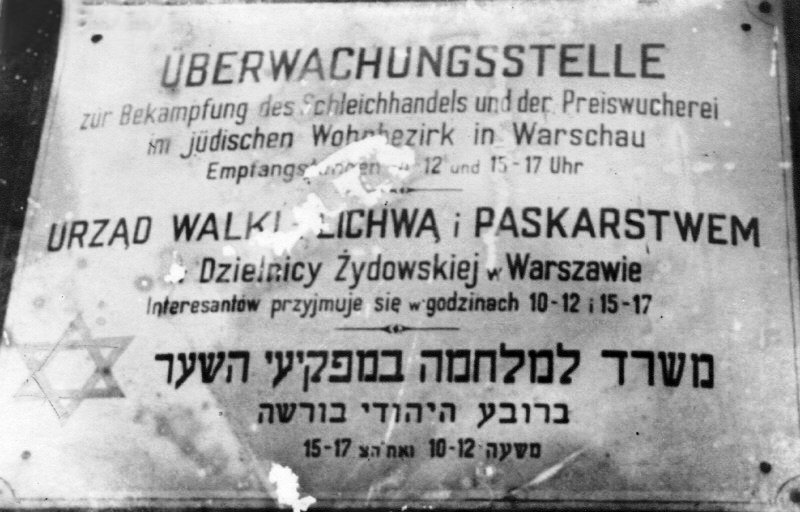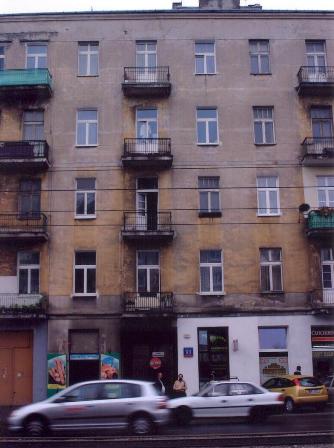Holocaust Education & Archive Research Team |
Revolt & Resistance
Acts of Resistance
Jewish Resistance
Groups Jewish Resistors Allied Reports Anti-Nazi Resistance Nazi collaborators
| ||||||
Abraham Gancwajch The "13" Nazi Collaborators in the Warsaw Ghetto
Abraham Gancwajch was born in Czestochowa but spent some time in Vienna and Lodz. He was a journalist and returned to Poland from Austria in 1936. In Lodz he worked as an editor of a pacifist anti-Nazi newspaper, but left Lodz and moved to Warsaw during the Nazi occupation.
He was the moving spirit behind the organisation known as the “Thirteen” which will be covered in greater detail below, which was dissolved in July 1941. He worked for the German Security Police in Warsaw, passing information to them about conditions in the ghetto, and the Jewish Underground.
The Thirteen (Trzynastka)
Within the Warsaw Ghetto an agency known as the “Thirteen” – Trzynastka in Polish – and Das Draitzental in Yiddish was established.
The agency took its name from the address of its headquarters at 13 Leszno Street, and was imposed on the ghetto by the Germans. The principal aim of the “Thirteen” which was founded in December 1940 was the Office to Combat Usury and Profiteering in the Jewish Quarter of Warsaw.
Its personnel sported polished boots, caps with a green band, epaulets and stars to denote rank. The ranks of the “Thirteen” numbered around three to four hundred men.
In May 1941 Abraham Gancwajch agency set up “First Aid” a kind of Red Cross emergency station. Gancwajch also established a department to supervise weights and measures in the Warsaw ghetto and an organisation of disabled veterans of the 1939 fighting, as well as cultural and religious societies.
Gancwajch’s past was shrouded in mystery, but his arrival and prominence in the Ghetto was no doubt sanctioned by the Germans, Gancwajch himself claimed that his privileged position grew out of his recommendation to the Germans by a relative of his, Moshe Merin, who was Chairman of the District Judenrat in Zaglebie.
Others claimed his rise to power was due to the recommendations of Dr. Ohlenbusch, whom Gancwajch had met when he was a journalist. Dr Ohlembush was in charge of the Propaganda department in Warsaw District, and subsequently was in charge of the Propaganda Department of Governor Frank’s administration in Cracow.
Stanislaw Adler recounted the membership conditions, and some of the members of the 13 cadres:
“The admission fee to become a member of the “13” was several thousand zlotys. At one point, when Gancwajch was in need of money, he began increasing the membership of his staff daily, and this provided him with a substantial sum of money.
This money was not for his personal use, but to pay bribes to the Germans to protect the “13” against threats of ending its existence. No special formalities or screening were used in recruiting candidates for the “13” so it comes as no surprise that elements from the criminal world became part of this organisation.
That the majority of these men became future Jewish Gestapo men, demonstrated who patronised the “13” and for the majority of the Jewish population, they viewed this organisation with suspicion and fear.
Amongst Gancwajch men were Dr Herbert Stahrer from Gdansk, his secretary and legal council and Dawid Sternfeld, a native of Lodz, who from his physical appearance could have been a boxer, a coolie or even a terrorist. This dull character was undoubtedly a Gestapo man, which did not save him from being executed by the Germans when he outlived his usefulness.”
The officials of the “13” took up their sentry posts at the ghetto gates along the walls of the ghetto and in the market place, but it is impossible to say whether their presence had any impact on reducing prices.
They managed to display an exceptional ability for promoting their own interests, the officials of the “13” possessed special provision cards with which they obtained bread and other products by blackmail. The threat of reporting a storekeeper on a charge of usury was so serious that each and every official of the “13” shortly found himself abounding in plenty.
In the beginning, the “13” had included the infamous Moritz Kohn and Zelig Heller, two promising young men from Lodz who had already acquired in the first year of the war a considerable fortune made by intervening to free arrested Jews from prison and cancelling confiscations.
They carried out their activities in a regular office where crowds of clients waited their turn. But work in the “13” proved too modest an occupation for Kohn and Heller and very soon they left the battle against usury and speculation and established their own horse-drawn tramway company. Both of these men were murdered by the Germans in August 1942.
Dr Stabenow of the Warsaw Ghetto Security Police acted as patron for Gancwajch and his clique, and the rise and fall of the “13” mirrored the clashes within the German Security forces. The “13” was not the only bone that the Gestapo had thrown to Gancwajch he was also responsible for the administration of approximately a hundred Jewish houses on Leszno Street.
In front of the candidates who aspired to jobs as house managers, Gancwajch delivered impassioned speeches in which he was severely critical of the Jewish Council, and forecasted his own reign and promised a blissful era in the Jewish Quarter.
The next of his many ventures was the formation of a Jewish Emergency Medical Service, the house committees were taxed on behalf of the Emergency Medical Service, many people resented the payment, but did so out of fear.
Dispensaries and out-patient clinics were established but never opened their doors, instead two-man patrols in the uniform of the Red Emergency Service circulated through the ghetto, in order to provide aid to the sick.
But in truth they ran in the other direction whenever they encountered anyone in need of assistance, since they had neither training or experience in first-aid matters. Their coffee flasks and bread containers were empty and their emergency kits contained only iodine.
Stanislaw Adler recalled the Emergency Medical Services ambulance:
“Gancwajch’s only real contribution to rescue operations was the ambulance that he put into action for the transport of the sick. This was a vehicle that had been in service for at least a hundred years, was in a bad shape, painted a repulsive shade of dirty blue and was drawn by a terribly emaciated, worn –out horse.
I could imagine a similar or perhaps the same vehicle being used years earlier for the transport of people stricken with cholera. Now, however, for an adequate fee it carried sick people, freeing the rickshaw from that task.”
The “Thirteen” and the Warsaw Judenrat were locked in a long and bitter struggle, and Adam Czerniakow was in an ideal position to describe his personal battles with Gancwajch and the eventual demise of the “Thirteen” in his diary:
December 3 1940
Gancwajch and Sternfeld paid us a visit. I asked them not to use the name of the Judenrat in their announcements.
May 8 1941
Several days ago Gancwajch organised a gathering (a tea party) and kept his guests through the night. Among those invited were Korczak, naturally Stanislaw Rozenberg, Glocer, etc. One of those present came to offer excuses for going there.
Gancwajch kept on bitching about the Community Authority, lying shamelessly that he will get the workshop going and indeed “cultural life.”
May 10 1941
In the morning I was informed by Scherer that he would be replaced by Knoll. Knoll inquired why Gancwajch and Sternfeld are trying to oust me from the Council, adding they are quite a pair, to which I retorted that that was indeed the case. Knoll then commented that the Community Authority would disintegrate in 10 days if they took it over.
May 30 1941
Auerswald said that the “13” is going to be subordinated to the Council. Gancwajch must be admitted to the Community Authority. To a question as to whether I am to take him into the Council he replied this would not be necessary, suggesting that he could perhaps be made our legal counsel. Gancwajch sent us a letter today with a request for admission.
June 6 1941
I received Gancwajch in the presence of Zundelewicz and Szerynski. He informed me that he was going to report to his authorities that the “13” personnel are to be incorporated into the Order Service, not as a unit, but dispersed, with a special section in the headquarters, and the enforcement of price control regulations decentralised in the precincts.
June 11 1941
Repeated threats from Gancwajch. He was to see the Kommissar today. I went with Szerynski to the Gestapo. Brandt called Levertzow for a conference. Levertzow told him that he is not Gancwajch’s protector.
July 21 1941
In the Community I received a letter from the Kommissar on the Gancwajch bureau. Has his career come to an end? Tempi di guerra tempi di carriera (In war’s gloom, careers bloom).
Even with the disbanding of the “Thirteen” network Czerniakow still had dealings with Gancwajch, and his entry for the 25 February 1942 reveals what he really thought about someone who had sold his soul to the Germans:
February 25 1942
I had a visit in my office from Gancwajch with pleas of a personal nature. What a despicable ugly creature.
May 27 1942
In the morning with Lejkin to Brandt. Brandt declared that if any Jewish family hides Gancwajch, Sternfeld Zachariasz, and one Zelman, it will suffer the consequences.
Abraham Lewin wrote about Gancwajch in his diary of the Warsaw ghetto, and it is clear to see that rumours played a large part in the accounts of the diarist’s.
May 24 1942
Last night once again a number of Jews were shot. At the moment we know the names of four of them: Szymonowicz, Hurwicz, Mandel and Lewin. They are all said to have been closely connected with the “Thirteen.”
The Nazis treat their assistants and servants, Jewish renegades and informers, according to an old German practice: the Moor has done his work, the Moor can go. Word has it that they visited the homes of the two “big men” Gancwajch, and Sternfeld, but they were not there. They are in hiding.
May 29 1942
Today rumours have been going round that Gancwajch has been caught in Otwock – others say it was in Radomsko or Czestochowa- and shot dead. As is well known the following four are wanted by the Germans: Gancwajch, Sternfeld and the Zachariasz brothers.
In every entrance hall in the ghetto there hangs an announcement that whoever hides the wanted men or helps them in any way whatsoever will be shot along with their entire family. The same fate threatens all the occupants of the building where one of the fugitives is found.
All of them worked together with the Germans and now they are being disposed of.
May 31 1942
Along with the rumours that Gancwajch has been detained and shot there are others that claim that he has already established himself far from here in Switzerland.
June 7 1942
This week the Germans arrested Zachariasz’ only daughter who is aged 18. They have been looking for him quite a while, along with Gancwajch, Sternfeld and Zelman. She is in Pawiak.
August 16 1942
According to certain reports, Czerniakow’s place here with us – a la Rumkowski will be inherited by Gancwajch, the man they had been hunting and trying to kill. He is outside the ghetto at the moment.
August 18 1942
I have heard talk again about the new rise of Gancwajch. He will take over Lichtenbaum ‘s place and become commissar of the Jewish community.
August 25 1942
There were telephone calls from Radomsko yesterday and today with the news that everything is quiet there, Gancwajch is there.
----------------------------------------------------------------------------------------------------------
After the destruction the bulk of the "13 membership, Gancwajch was spotted outside the ghetto on the Aryan side of Warsaw. Here he pretended to be part of the Jewish underground hunting Nazi sympathetic Poles.
Sources:
The Warsaw Diary of Adam Czerniakow published by Elephant Paperbacks 1999. The Jews of Warsaw 1939 -1943 by Yisrael Gutman published by The Harvester Press Brighton 1982. In the Warsaw Ghetto – The Memoirs of Stanislaw Adler, published by Yad Vashem, Jerusalem 1982. A Cup of Tears by Abraham Lewin, published by Fontana/ Collins 1990
Copyright: David Watts and Victor Smart H.E.A.R.T 2008
|
